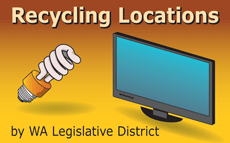Mercury Factsheets & Guides
 Mercury-containing lamp stewardship: LightRecycle Washington (PDF)
Mercury-containing lamp stewardship: LightRecycle Washington (PDF)
Washington's statewide mercury-containing light stewardship program, recycled over 4 million lights 2015-2018. NWPSC handout, October 2018
 NWPSC Mercury Subcommittee Issue Paper (PDF).
NWPSC Mercury Subcommittee Issue Paper (PDF).
Northwest Product Stewardship Council, 2010.
BC LightRecycle Program Fact Sheet
Fact sheet (PDF) for Product Care Assocation's British Columbia LightRecycle program for all kinds and quantities of lights (2012).
Washington State Department of Ecology Persistent Bioaccumulative Toxin
The Department of Ecology completed a Mercury Chemical Action Plan in 2003 as part of its Persistent, Bioaccumulative Toxics (PBT) Initiative. Ecology's PBT Strategy calls for continually reducing and, where possible, eliminating PBTs by the year 2020 by phasing out the use, production, and where possible, releases of these chemicals
 NWPSC Bulletin Vol 1, Issue 2: Mercury - a Highly Toxic and Costly Challenge (PDF file, 422KB).
NWPSC Bulletin Vol 1, Issue 2: Mercury - a Highly Toxic and Costly Challenge (PDF file, 422KB).
Northwest Product Stewardship Council. July 2002.
 NWPSC Policymakers Bulletin - Mercury: Highly Toxic and Costly Challenge (PDF file, 421KB)
NWPSC Policymakers Bulletin - Mercury: Highly Toxic and Costly Challenge (PDF file, 421KB)
This Policymakers' Bulletin explains the problems with products that contain mercury and how local governments in Washington and Oregon are making mercury reduction a top priority.
Cleaning up mercury contamination is a costly problem, this bulletin describes how product stewardship practices in combination with government policy can reduce further cleanup costs by decreasing the amount of future mercury pollution. The bulletin outlines action steps governments can take to influence product stewardship practices and help to clean up and reduce mercury pollution.
